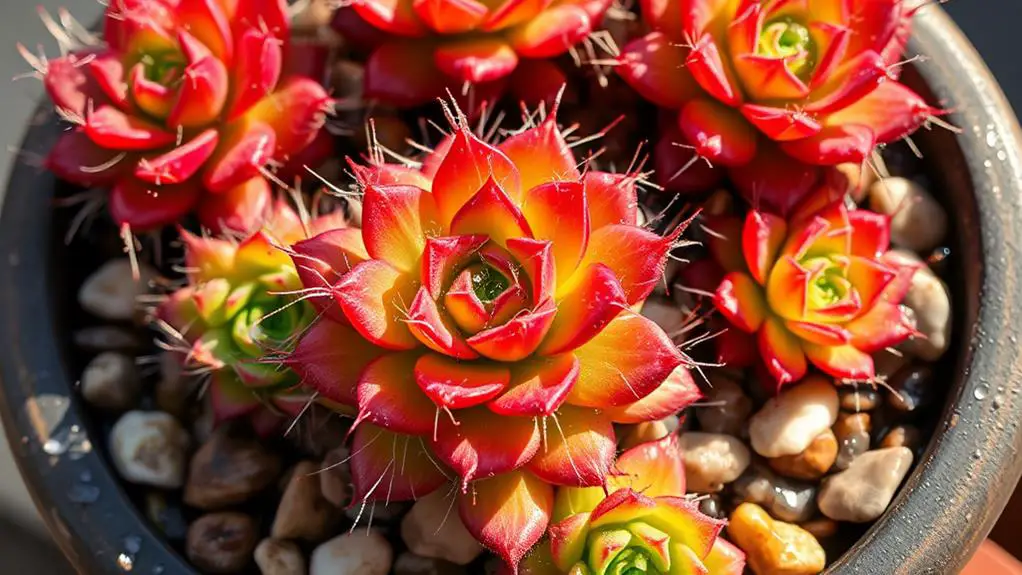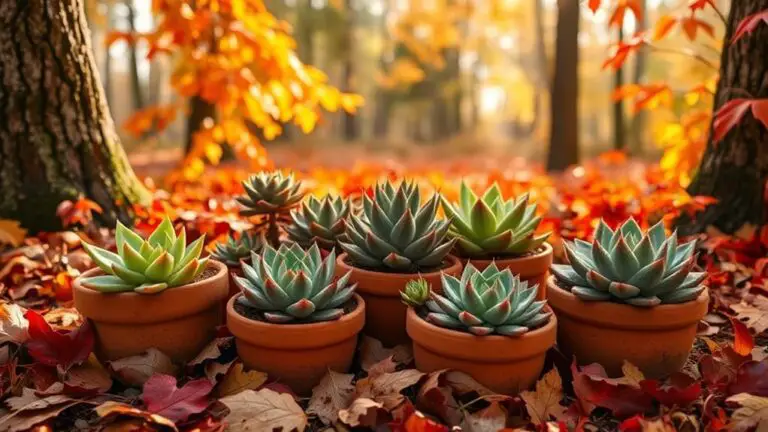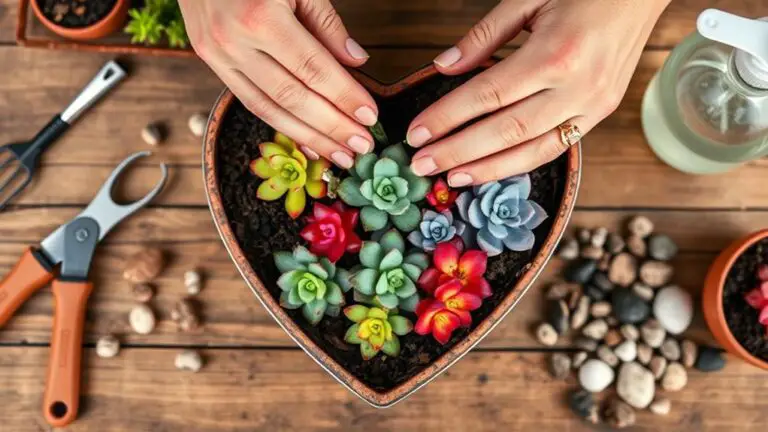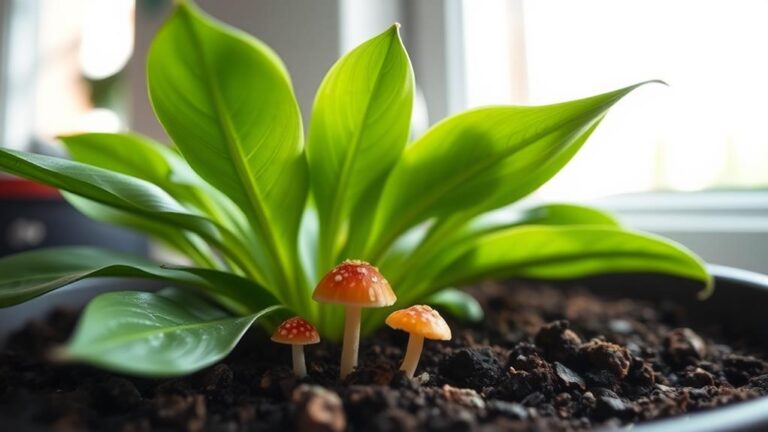Essential Tips for Sempervivum Cobweb Care
When it comes to caring for your Sempervivum Cobweb, understanding its unique needs can make all the difference. You'll want to guarantee it gets ample sunlight without being scorched by harsh afternoon rays. Using fast-draining soil and watering sparingly are vital to prevent root rot. But that's just the beginning. Do you know how to balance temperature and pruning to encourage denser foliage? And what about pest management? Each step is fundamental to maintaining a healthy, thriving plant. Let's explore these vital tips in more detail to keep your Sempervivum Cobweb at its best.
Characteristics
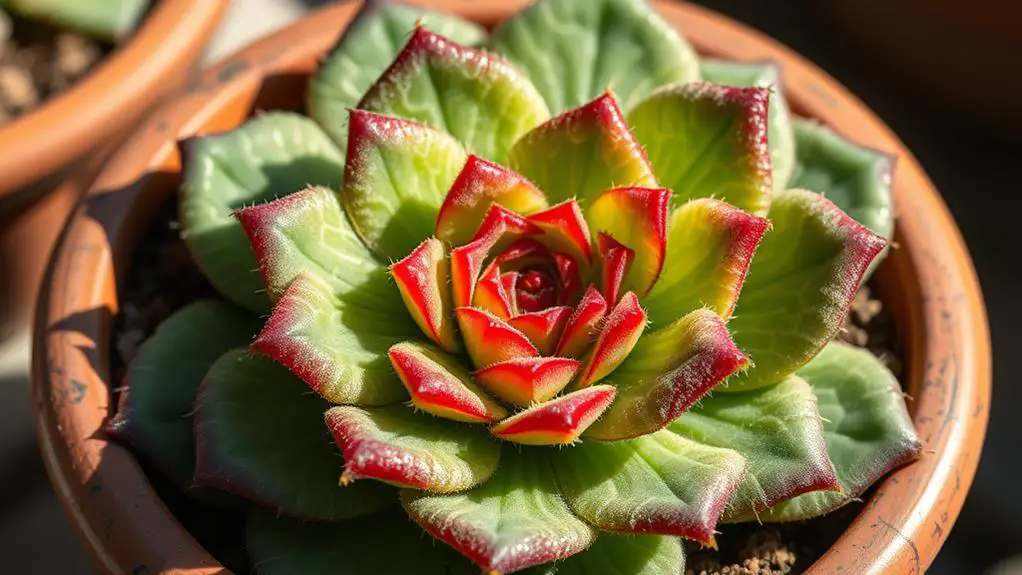
Sempervivum Cobweb, also known as Cobweb Houseleek, stands out with its unique appearance and hardy nature. This fascinating succulent belongs to the Crassulaceae family and is native to the Alps. Its rosettes consist of fleshy, pointed leaves that are covered in fine white hairs, giving them a cobweb-like appearance.
These rosettes can grow between 3 to 5 inches wide and can reach up to 3 inches tall. As you care for your Sempervivum Cobweb, you'll notice it can spread up to 12 inches wide, forming a tight mat. This growth habit makes it an excellent ground cover in suitable conditions.
One interesting characteristic is that it's monocarpic. This means the mother rosette will die after blooming. However, don't worry! It will produce offsets, or "chicks," that continue growing and keep your succulent thriving.
Cobweb Houseleek is incredibly hardy, tolerating both drought and cold. It thrives in USDA zones 5a to 8b and can handle temperatures as low as 20°F. With its unique cobweb-like leaves and ability to produce offsets, Sempervivum Cobweb is a delightful addition to any succulent collection.
Growing Conditions
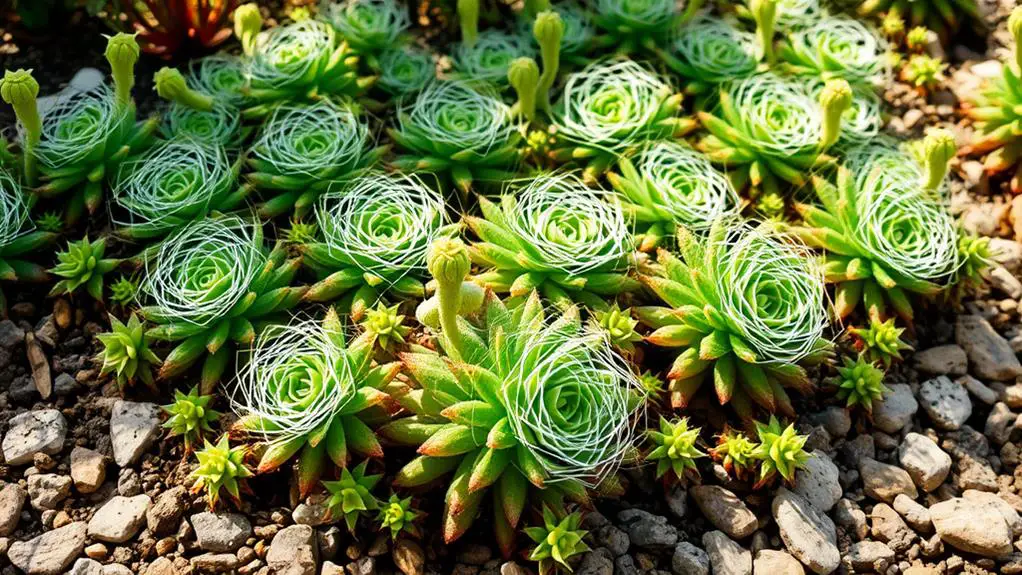
To grow Sempervivum Cobweb successfully, you need to focus on light, soil, and temperature.
Make sure it gets at least 6 hours of direct sunlight daily, but protect it from harsh afternoon rays to avoid leaf burn.
Use well-draining soil and water sparingly, especially in the winter, to keep it healthy and thriving.
Optimal Light Exposure
Wondering how to give your Sempervivum Cobweb the best chance to thrive? Ideal light exposure is key. This plant loves bright indirect sunlight, so placing it less than 1 foot from a south-facing window is perfect. Aim for 4-6 hours of sunlight daily. Full sun to partial sun conditions are suitable, but be cautious if you live in a hot climate. Too much intense afternoon sun can cause leaf burn.
To guarantee your Sempervivum Cobweb gets just the right amount of light, remember these tips:
- Full Sun: Provides robust growth but avoid intense midday sun to prevent leaf burn.
- Partial Sun: A mix of direct and indirect light works well.
- Bright Indirect Sunlight: Keeps the plant healthy without the risk of damage.
Avoid placing your plant in low-light conditions. It can lead to leggy growth, where the plant stretches out and weakens. This not only makes it look less attractive but also reduces its health.
Always consider regional weather when positioning your Sempervivum Cobweb, guaranteeing it gets the light it needs year-round. With the right light, your plant will flourish, adding a unique touch to your space.
Soil and Watering
While ideal light exposure is essential, the right soil and watering practices are just as important for your Sempervivum Cobweb to thrive.
Start by using fast-draining soil. Mix regular potting soil with coarse sand or perlite. This helps prevent root rot, which can be a major issue if the soil holds too much water.
Water sparingly and let the soil dry completely between watering sessions. In the summer, you'll typically need to water every 1-2 weeks. During winter, reduce watering even further. The plant's growth slows down, and it needs less moisture.
Overwatering can lead to root rot. Watch for signs like wilting or mushy leaves, as these indicate that the roots might be in trouble.
When it comes to light, place your Sempervivum Cobweb in bright indirect light. A spot near a south or west-facing window is perfect. This light condition supports healthy growth without scorching the leaves.
Temperature Tolerance
Understanding the temperature tolerance of your Sempervivum Cobweb is vital for keeping it healthy and vibrant. This succulent thrives in temperatures ranging from 60°F to 75°F (15°C to 24°C) during the growing season, making it perfect for most climates.
However, it's also cold-hardy and can withstand freezing temperatures as low as 20°F (-6°C) in USDA zones 5-8.
For indoor care, aim for temperatures between 50°F to 65°F (10°C to 18°C) during winter dormancy. This range guarantees the plant rests properly, preparing it for the next growing season.
Keep in mind that Sempervivum Cobweb prefers stable conditions and should be shielded from extreme temperature fluctuations.
- Resilient to cold weather: Can survive freezing temperatures down to 20°F (-6°C).
- Optimal indoor climate: Maintain 50°F to 65°F (10°C to 18°C) during winter.
- Stable environments: Protect from sudden temperature changes.
Good drainage is essential to prevent waterlogging, especially in colder climates with heavy rain or snow.
Make sure your plant sits in a well-draining medium, and consider light shade if temperatures rise too high.
With these tips, your Sempervivum Cobweb will thrive, no matter the weather!
Light Requirements
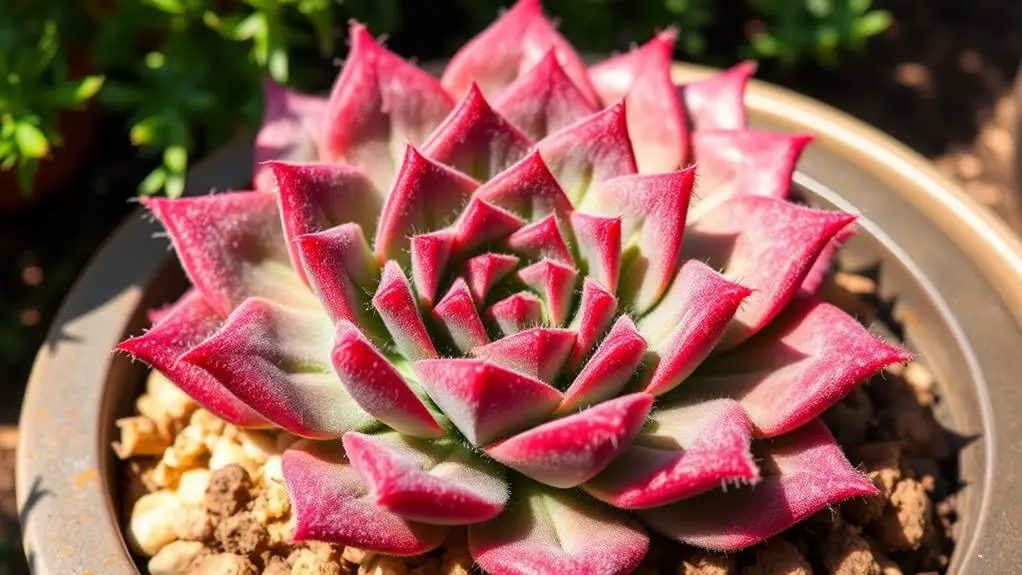
For ideal growth, Sempervivum Cobweb thrives in bright, indirect light. Placing your plant near south or west-facing windows is perfect. This succulent needs at least 4-6 hours of direct sunlight daily to keep its foliage healthy and colorful. However, prolonged exposure to low-light conditions can cause leggy growth and weaken the plant.
In hotter climates, be cautious of the intense afternoon sun. While morning sun is beneficial, too much afternoon sun can burn the leaves. It's important to adjust your plant's light exposure based on regional weather patterns to guarantee it gets the right amount of light. Here's a table to help you understand the light requirements better:
| Light Condition | Effect on Sempervivum Cobweb |
|---|---|
| Bright Indirect Light | Ideal growth, healthy foliage |
| Direct Sunlight (4-6 hours) | Maintains vibrant coloration |
| Low-Light Conditions | Leads to leggy growth, poor health |
| Morning Sun | Beneficial, promotes growth |
| Intense Afternoon Sun | Risk of leaf burn |
Watering Guidelines

When it comes to watering your Sempervivum Cobweb, less is more. These resilient plants thrive on minimal water, so it's vital to get the watering schedule just right. During spring and summer, aim to water every 1-2 weeks. In the cooler fall and winter months, reduce the frequency considerably. Always wait until the soil is completely dry before watering again to prevent root rot.
To guarantee success, follow these key tips:
- Use room temperature water: Cold water can shock the plant.
- Direct water to the soil: Avoid wetting the leaves to prevent rot.
- Monitor soil moisture: Overwatering can cause wilting or mushy leaves.
Your plant's health relies on not overdoing it. Too much water can lead to excess water around the root system, causing damage.
A high drainage soil mix is essential to keep the roots dry and healthy. Consider using a water calculator to tailor your watering schedule based on environmental conditions and the plant's needs.
Soil and Potting
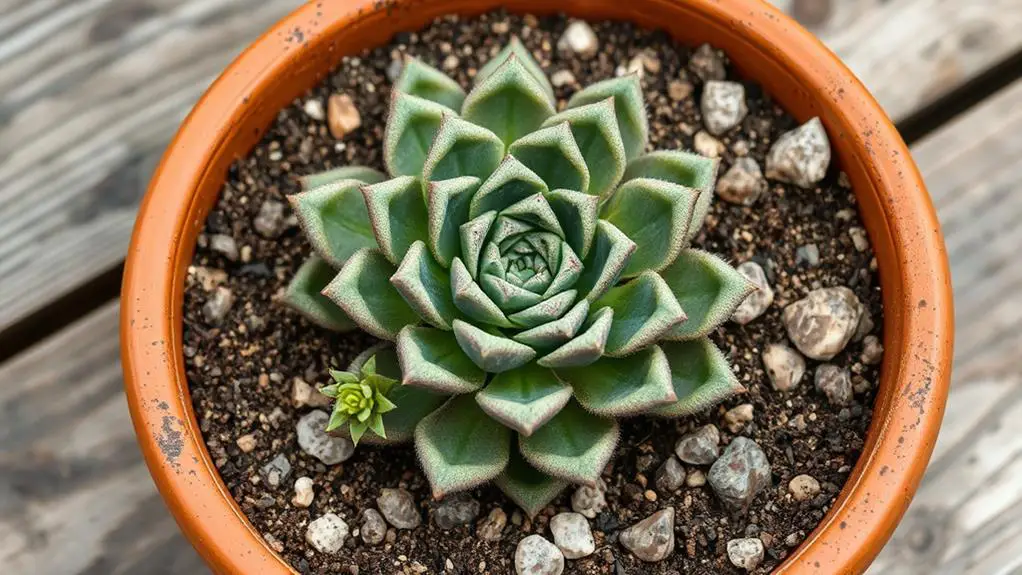
To guarantee your Sempervivum Cobweb thrives, start with the right soil and potting materials. Using fast-draining soil is essential. A sandy or gravelly mix will prevent root rot and keep your succulent healthy.
Good drainage is vital, so choose porous potting materials like terracotta or ceramic. These materials help excess water escape, which protects your plant from water damage.
When repotting your Sempervivum, pick a pot that's 5-10% larger than the current one. This allows room for growth without restricting the roots. The best time for repotting is during the summer growing season. This timing helps the plant adjust more easily to its new environment.
Be gentle when handling the offsets, as they're delicate.
It's also important to regularly check the soil for pests and mold. Healthy drainage will prevent these issues, but it's good to be vigilant. If you notice any problems, address them quickly to keep your plant thriving.
Pruning and Propagation
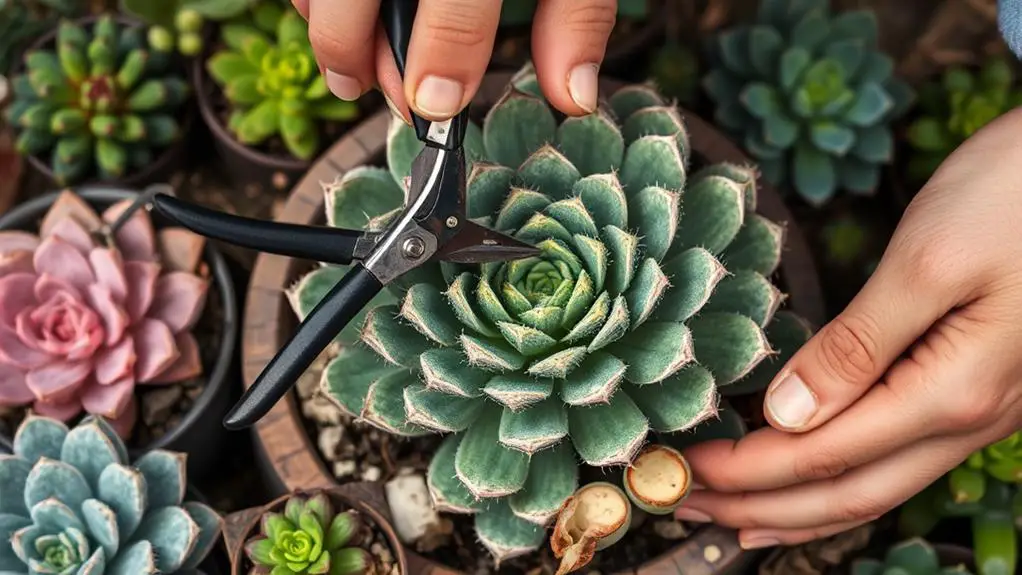
After ensuring your Sempervivum Cobweb has the right soil and potting conditions, it's time to focus on pruning and propagation. Pruning isn't often needed, but if your plant becomes leggy due to insufficient light, you should trim back the elongated leaves with clean scissors. This helps encourage denser growth and keeps the plant looking tidy.
Key Steps:
- If your plant flowers, remove the dead rosette afterward to maintain the health of the surrounding offsets.
- When propagating, wait until the offsets (chicks) are 1-2 inches tall before gently removing them from the mother plant.
- Keep new plants from offsets or leaf cuttings in indirect light until they establish roots.
For propagation, separating offsets is the easiest method. These small rosettes grow around the mother plant and can be gently removed once they're about 1-2 inches tall.
Another method is using leaf cuttings, but make sure to let them callous in dry conditions for a few days to prevent rot before planting.
Place these new plants in indirect light until they grow roots and start to thrive. With these steps, you'll keep your Sempervivum Cobweb healthy and multiplying, ensuring a beautiful, lush display.
Pest Management
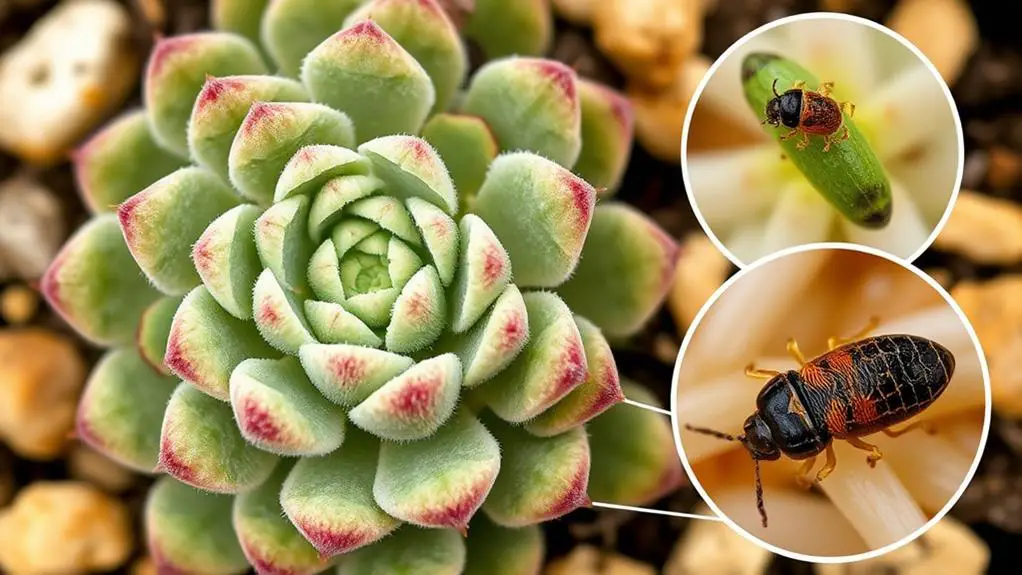
Pest management is essential for keeping your Sempervivum Cobweb healthy and vibrant. Regularly inspect your Cobweb Houseleek for pests like aphids, mealybugs, spider mites, and scale. These pests can weaken your plant if left untreated. When you spot them, act quickly. Use neem oil or insecticidal soap, following the product instructions for the best results. Neem oil is particularly effective and safe for your plant.
To help you stay on top of things, here's an emotional guide to pest management:
| Emotion | Action | Outcome |
|---|---|---|
| Worried | Inspect plants regularly | Early pest detection |
| Determined | Apply neem oil | Effective pest control |
| Calm | Avoid overhead watering | Reduce fungal infections |
| Confident | Isolate affected plants | Prevent spread |
| Reassured | guarantee healthy plant care | Less susceptible plants |
Avoid overhead watering to reduce the risk of fungal infections. These thrive in overly moist conditions and can lead to plant decline. Always practice healthy plant care. Strong and well-maintained Sempervivum are less likely to suffer from pest infestations and diseases. If you see signs of pest damage, isolate the affected plant to prevent spreading to others. Following these tips will keep your Sempervivum Cobweb thriving!
Uses and Benefits
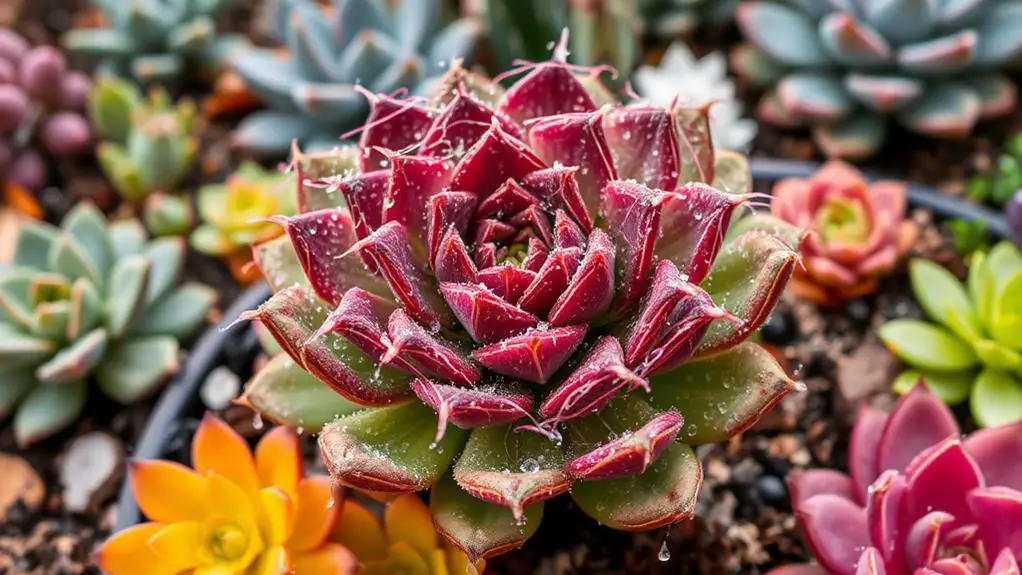
Keeping your Sempervivum Cobweb free from pests guarantees it thrives and maintains its health, allowing you to fully appreciate its many uses and benefits. This remarkable plant, also known as Cobweb Houseleek, offers a variety of advantages that go beyond its aesthetic appeal. Understanding these benefits can help you make the most out of your succulent plants.
First, the leaves of Sempervivum Cobweb have impressive medicinal properties. You can crush or juice them to create natural remedies for wounds and boils. It's a handy home remedy that's both simple and effective.
- Treat wounds and boils: Use crushed leaves or juice for natural healing.
- Oral relief: Chewing the leaves can ease toothaches.
- Skin benefits: Apply the plant's pulp as a cooling face mask in summer.
In addition to its health benefits, the plant enhances garden aesthetics with its unique cobweb-like appearance and vibrant blooms every three years.
Plus, Sempervivum Cobweb is non-toxic to humans and pets, making it a safe and attractive option for households with children and animals.
With proper Cobweb Houseleek Care, you can enjoy its many benefits while keeping your garden beautiful and safe.
Frequently Asked Questions
How to Care for Cobweb Succulents?
To care for Cobweb Succulents, give them 4-6 hours of sunlight, water sparingly, and use fast-draining soil. Check for pests regularly and separate offsets for propagation. Keep the soil dry between waterings to prevent root rot.
Why Are My Sempervivum Cobwebs Turning Brown?
Your Sempervivum cobwebs are turning brown likely due to underwatering, excessive sunlight, overwatering, or environmental stress. Guarantee you provide occasional moisture, filtered light, and stable temperatures while avoiding root rot and fungal infections for healthy plants.
How Often Do You Water Cobweb Houseleek?
You should water your Cobweb Houseleek every 1-2 weeks in spring and summer, letting the soil dry completely. In winter, reduce to once every 3-4 weeks. Always check soil moisture to avoid overwatering.
How Do You Care for Sempervivum Indoors?
Place your Sempervivum near a sunny window, water sparingly when the soil is dry, use well-draining soil, maintain temperatures between 50°F and 65°F, and monitor for pests. Avoid overwatering to prevent root rot and fungal infections.
Conclusion
Caring for your Sempervivum Cobweb can be a rewarding experience. By giving it the right amount of sunlight, proper watering, and well-draining soil, you'll help it thrive. Don't forget to prune when needed and keep an eye out for pests. With these simple tips, your plant will stay healthy and beautiful. Remember, you've got this! Your dedication will pay off, and your Sempervivum Cobweb will flourish under your care. Happy gardening!

